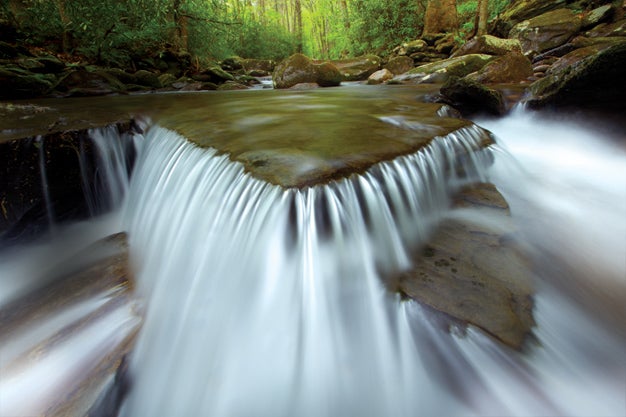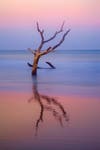Introduction to slow shutter speed photography
Embrace the blur.

The magic of photography has always been its ability to freeze an instant in time—to capture what Henri Cartier-Bresson famously termed the decisive moment. It’s magical because we can’t see the world in that way—we have no pause button to savor our experiences stopped in time. But a single, frozen instant doesn’t express motion very well, and that’s where long exposures can add another dimension to still photography—the dimension of time. You can take what would be a static image captured at a fast shutter speed and transform it into something dynamic. An effective tool for artistic interpretation, it’s also fun and, with just a little practice, easy to do with ordinary photo gear.

Autumn Maples, Great Smoky Mountains National Park
The Water Ballet
For a nature photographer, no other subject presents better opportunities for capturing long exposures than moving water. Waterfalls, cascading streams, and ocean waves are but a few examples.
You’re going to need a tripod, a remote shutter release or the camera’s 2-second self-timer to avoid camera shake, and preferably overcast lighting conditions. The lower light in them makes it easier to achieve longer shutter times, and the light is more aesthetically pleasing, too.
I approach a waterfall or stream scene just as I would any other landscape. I work in aperture-priority auto mode (Av or A), choose an f-stop that gives the desired depth of field, then adjust the ISO until I get the shutter speed I want—higher ISO for faster speeds, lower one for longer exposures. I often need a smaller aperture than necessary to slow things down.
That’s because one problem encountered in long-exposure photography is too much light. If you just can’t leave the shutter open long enough without overexposing the image, opt for a neutral-density (ND) filter. These reduce the amount of light entering the lens, allowing for longer exposure times than would be possible otherwise. The key is that they reduce light uniformly, so contrast and dynamic range are not affected—unlike a split neutral-density filter.
ND filters are available in different strengths designated by either the number of stops they soak up or in terms of optical density. A 3-stop or 0.9 density ND is ideal for waterfalls in bright sunlight, slowing the exposure to a second or so. A strong 10-stop or 3.0 ND can blur clouds over several minutes, even on a bright, sunny day. Variable ND filters are also available, although these can be expensive.
How much you should slow things down is a matter of personal taste. The volume of water plays a big part in making the decision: Longer exposures work best with lighter streams and help express grace or fragility. Relatively faster shutter speeds are more effective for heavier cascades, as they help convey the feeling of power or strength. My own preference is to keep some texture and detail, and that means shutter speeds of 0.5 to 4 seconds for most situations, but there are plenty of exceptions.
For ocean waves, a very long shutter speed—20 seconds to several minutes—can smooth out the water and reduce distraction in the image. Waves, surface undulations, and refracted light all blend together into a creamy, smooth surface, leaving only the essential elements that make a powerful composition.

Tree in Wet Sand, Hunting Island State Park, SC
Tracking Motion
Panning is a technique in which you move the camera parallel to the subject. The subject remains relatively sharp, while the background blurs due to the motion of the camera. This is a great technique for moving wildlife or birds in flight.
I will use shutter-priority auto (Tv or S) since I am looking for a very specific shutter speed and the depth of field is nearly irrelevant—everything but the moving object will be blurry anyway. I usually start with a shutter speed of 1/15 sec and modify if needed. If there is too much blur in the moving subject, I will speed up to 1/20, 1/25, or 1/30 sec. For subjects that are moving too slowly for a good effect, I’ll try a slower shutter speed. It pays to experiment until you get the effect you want.
A tripod isn’t necessary when panning and will probably be more of a hindrance than a help. Set both autofocus and drive modes to continuous, and turn on image stabilization if you have it. (Many newer lenses will automatically stabilize along the opposite axis you are panning; older lenses have a manual switch for panning mode.) Use a smooth turn of the torso and begin focus-tracking the subject well before you shoot.
Gently press the shutter release and hold it down to take many exposures. Continue to track the subject until after the exposures are taken, which will help avoid the tendency to stop panning once the shutter is pressed.
The more blur you capture in your image, the more abstract the moving subject becomes. I like to see literal elements in the image, with just a hint of blur to give it a dynamic feel.

Snow Geese, Pocosin Lakes National Wildlife Refuge, NC
Panning for Abstracts
Panning stationary subjects or scenes vertically or horizontally is a great long-exposure technique that creates a dreamy, painterly look (click here for a slight diagonal pan)). One ideal situation is a forest or stand of trees with many strong vertical elements within it. Here, you can pan the camera vertically along the prominent tree trunks during a long exposure. Horizontal panning of a clean, even horizon along a coast can also produce some beautiful results.
Shutter speeds of 1 to 6 seconds are best for these images, but you should try others on your own. Pan slowly with a long-er exposure, or quickly with a shorter one. Try keeping the camera still for half of the exposure and moving it though the other half; this imprints more literal elements of the scene while introducing just a touch of blur.

Clouds and Fog at Twilight, Clingmans Dome, Great Smoky Mountains National Park
Stretch it Out
Your camera’s meter helps give you the right exposure for shutter speeds of 30 seconds or less. But what if you want or need an exposure time of several minutes? Try this: In manual-exposure mode, select 30 seconds for the shutter speed, an ISO of 100, and the appropriate f-stop for depth of field considerations. During late twilight, early dawn, or if using a strong ND filter, your meter will likely indicate underexposure.
Now, increase the ISO in full EV steps until the meter indicates correct exposure. If it’s two steps—for example, ISO 100 to 400— then double the exposure speed for each step, here 30 seconds to 2 minutes. Then reset the ISO back to 100 and the exposure mode to Bulb.
Shutter speeds of several minutes can transform a raging ocean into a smooth, creamy, luminous sea, and a sky full of afternoon clouds into dynamic streaks of light that span the sky.
Richard Bernabe is a professional nature and travel photographer from South Carolina. He has written many photo instruction books and leads workshops and tours all over the world.